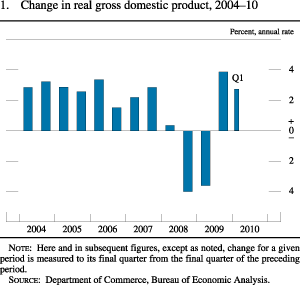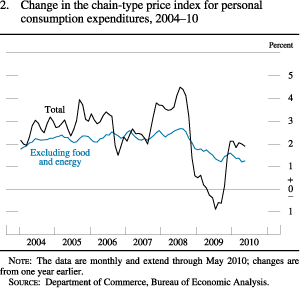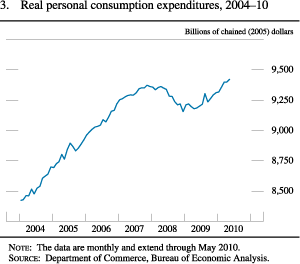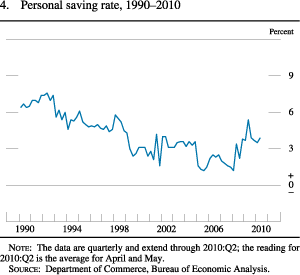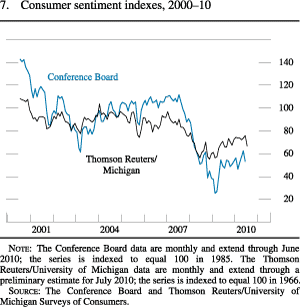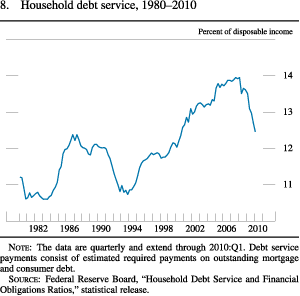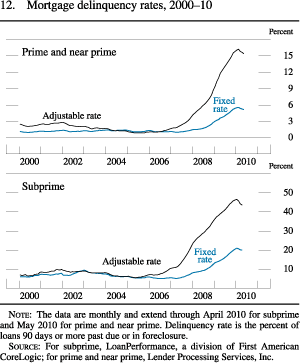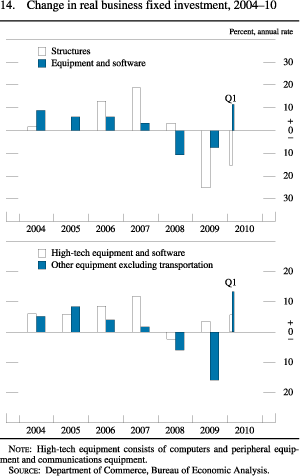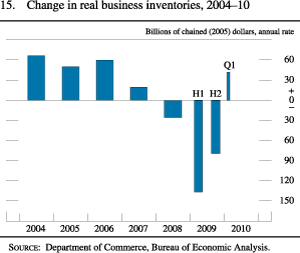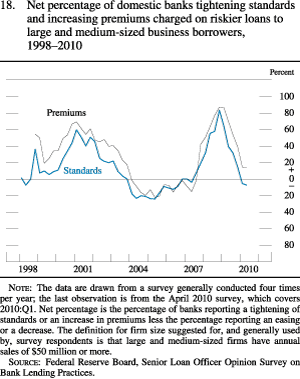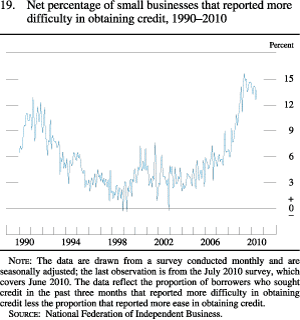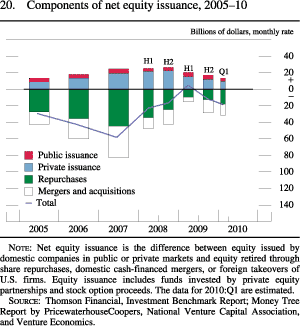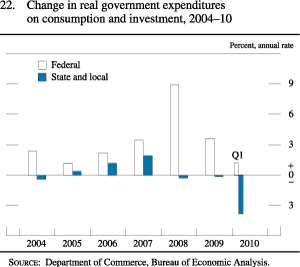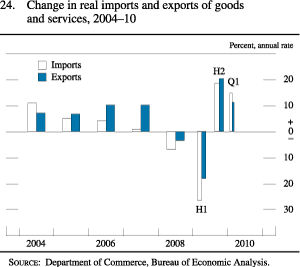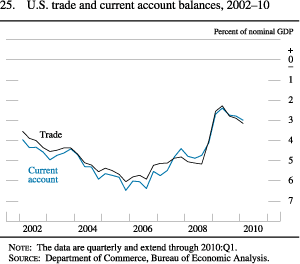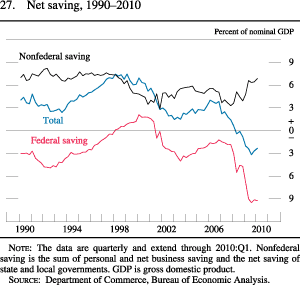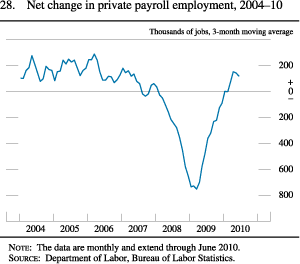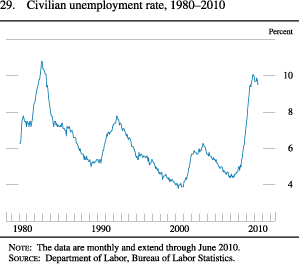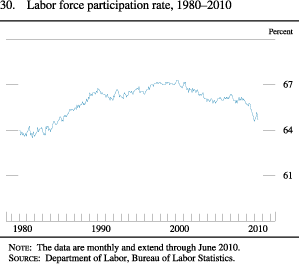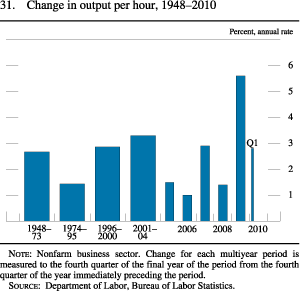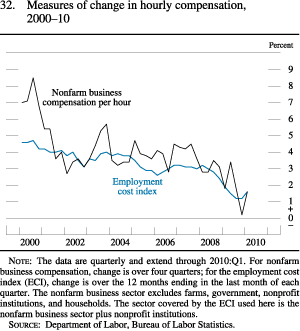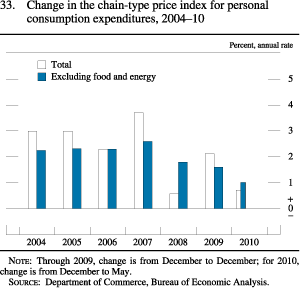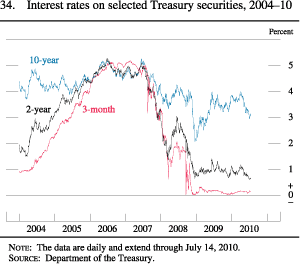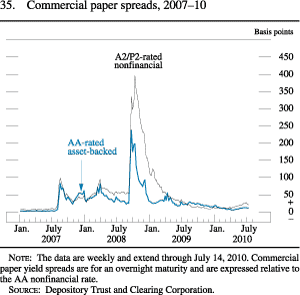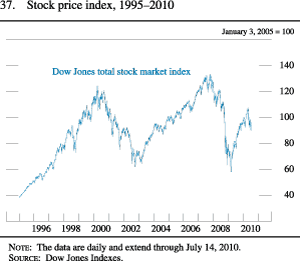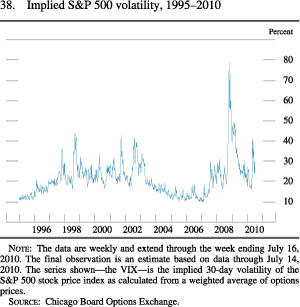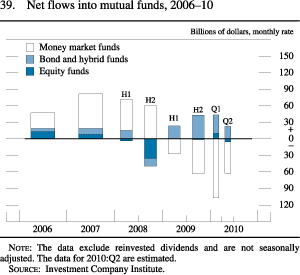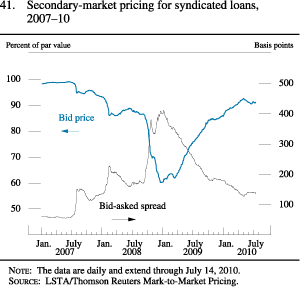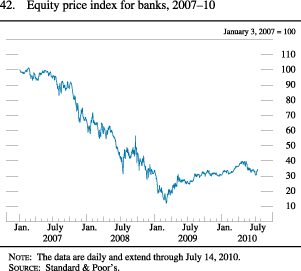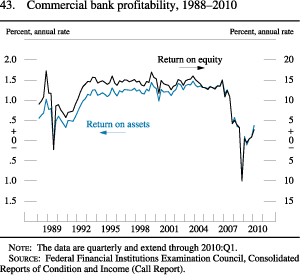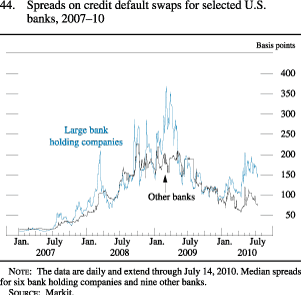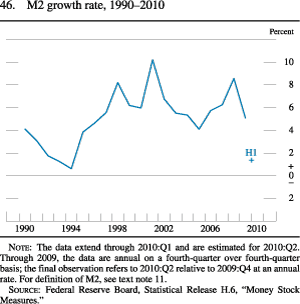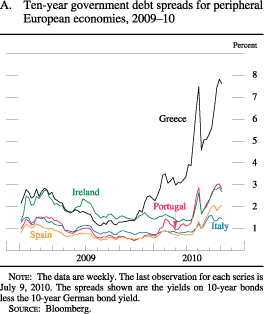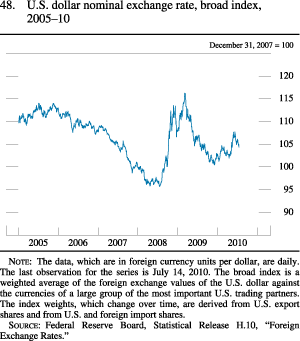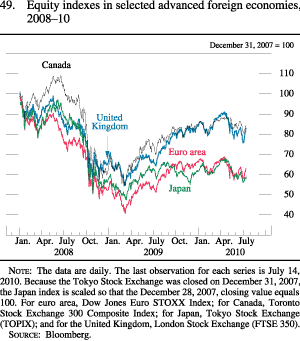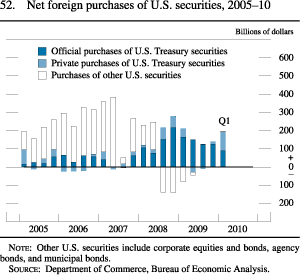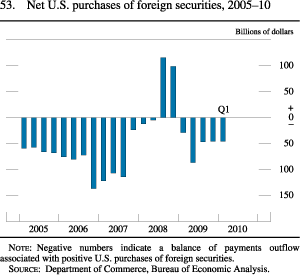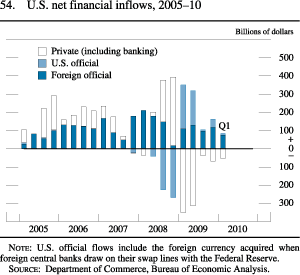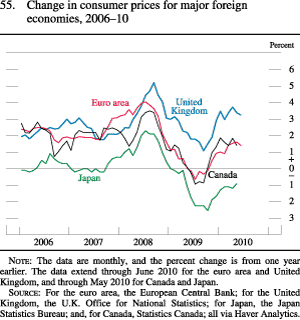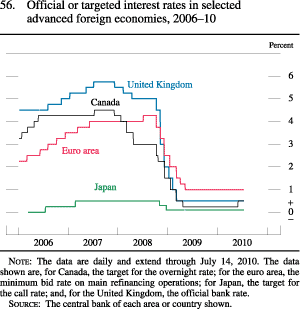- July 21, 2010: Part 1
- Part 2
- Part 3
- Part 4
- Abbreviations
- Printable Version (965 KB PDF)

Sections of Part 2
Part 2: Recent Financial and Economic Developments
Monetary Policy Report submitted to the Congress on July 21, 2010, pursuant to section 2B of the Federal Reserve ActReal gross domestic product (GDP) increased at an annual rate of 2-3/4 percent in the first quarter of 2010 after rising about 4 percent on average in the second half of 2009, and it apparently posted another moderate gain in the second quarter (figure 1).1 Some of the impetus to the continued recovery in economic activity in the first half of the year came from inventory investment as businesses started to rebuild stocks after the massive liquidation in the latter part of 2008 and in 2009. In addition, final sales continued to firm as consumer spending moved up, businesses raised their outlays for equipment and software, and demand for U.S. exports strengthened. In contrast, the underlying pace of activity in the housing sector has improved only marginally since hitting bottom in 2009. In the labor market, employment rose gradually over the first half of 2010 and average weekly hours worked increased, but the unemployment rate fell just slightly. Headline consumer price inflation has been low this year, as energy prices have dropped and core inflation has slowed (figure 2).
The gradual healing of the financial system that began in the spring of 2009 continued through the early spring of 2010. In the first quarter, financial market conditions generally became more supportive of economic activity, with yields and spreads on corporate bonds declining, broad equity price indexes rising, and measures of stress in many short-term funding markets falling to near their pre-crisis levels. In late April and early May, however, concerns about the effects of fiscal pressures in a number of European countries led to increases in credit spreads on many U.S. corporate bonds, declines in broad equity price indexes, and a renewal of strains in some short-term funding markets. Even so, over the first half of the year, mortgage rates and yields on U.S. corporate securities remained at low levels.
Domestic Developments
The Household Sector
Consumer Spending and Household Finance
Personal consumption expenditures (PCE) appear to have posted a moderate advance in the first half of 2010 after turning up in the second half of 2009 (figure 3). The improvement in employment and hours worked, and the associated pickup in real household incomes, provided important impetus to spending. The rise in household net worth in 2009 and the first quarter of 2010 also likely helped buoy spending, although the drop in stock prices during the spring unwound some of the earlier increase in wealth and--all else being equal--may restrain the rise in real PCE in the second half of the year. The personal saving rate has fluctuated in a fairly narrow range since the middle of 2009, and it stood at 4 percent in May (figure 4).
The gains in consumer spending during the first half of 2010 were widespread. Sales of new light motor vehicles (cars, sport utility vehicles, and pickup trucks) rose from an annual rate of 10-3/4 million units in the fourth quarter of 2009 to 11-1/4 million units in the second quarter, supported in part by favorable financing conditions for auto buyers. Spending for other goods started the year on a strong note--perhaps boosted by pent-up demand for purchases that had been deferred during the recession--though it appears to have cooled somewhat during the spring. Real outlays for services increased modestly after having only edged up in 2009.
Aggregate real disposable personal income (DPI)--personal income less personal current taxes, adjusted to remove price changes--rose at an annual rate of more than 3-1/2 percent over the first five months of the year after barely increasing in 2009 (figure 5). Real wage and salary income, which had fallen appreciably in 2009, has regained some lost ground this year, as employment and hours of work have turned up and as real hourly wages have been bolstered by the very low rate of PCE price inflation. One measure of real wages--average hourly earnings of all employees, adjusted for the rise in PCE prices--increased at an annual rate of roughly 1 percent over the first five months of 2010 after having been about flat over the 12 months of 2009.
With equity values up and house prices holding steady, the ratio of household net worth to DPI edged higher in the first quarter of 2010 after increasing appreciably over the last three quarters of 2009. Nonetheless, the wealth-to-income ratio at that time was well below the highs of 2006 and 2007 (figure 6). Moreover, equity prices have fallen substantially since the end of the first quarter, a development that has not only depressed net worth but has also adversely affected consumer sentiment in recent months (figure 7).
Households continued to reduce their debt in the first half of 2010. Total household debt contracted at an annual rate of about 2-1/2 percent in the first quarter of 2010, with both mortgage debt and consumer credit posting declines. The fall in consumer credit was less rapid than it had been in the second half of 2009, a development that is consistent with banks' increased willingness to extend consumer installment loans that has been reported in recent results of the Senior Loan Officer Opinion Survey on Bank Lending Practices (SLOOS).2 However, SLOOS respondents also continued to report weak demand for such loans. Reflecting the contraction in household debt, debt service payments--the required principal and interest on existing mortgages and consumer debt--fell as a fraction of disposable income (figure 8).
Changes in interest rates on consumer loans were mixed during the first half of 2010. Interest rates on new auto loans edged down on balance, and spreads on these loans relative to Treasury securities of comparable maturity remained near their average levels over the past decade. Interest rates on credit card loans rose through the first half of 2010; part of the increase early in the year may be attributable to adjustments made by banks prior to the imposition of new rules in February under the Credit Card Accountability Responsibility and Disclosure (Credit CARD) Act.3
Although delinquency rates on auto loans at captive finance companies and on credit card loans at commercial banks edged down in the first quarter of 2010, they remained at elevated levels. Charge-off rates for credit card loans at commercial banks were also high.
The Federal Reserve's Term Asset-Backed Securities Loan Facility (TALF) continued to support the issuance of consumer asset-backed securities (ABS) until its closure for such securities on March 31 (figure 9).4 Subsequently, issuance of consumer ABS was solid during the second quarter. Yields on such securities fell on balance during the first quarter, and spreads on high-quality credit card and auto loan ABS relative to comparable-maturity Treasury securities declined to levels last seen in 2007.
Residential Investment and Housing Finance
Home sales and construction were boosted in the spring by the homebuyer tax credit. But looking through this temporary improvement, underlying housing activity appears to have remained weak this year despite a historically low level of mortgage interest rates. In an environment of soft demand, a large inventory of foreclosed or distressed properties on the market, and limits on the availability of financing for builders and some potential buyers, homebuilding has stayed at a slow pace. In the single-family sector, new units were started at an average annual rate of about 510,000 units between January and June--just 150,000 units above the quarterly low reached in the first quarter of 2009 (figure 10). Activity in the multifamily sector has continued to be held down by elevated vacancy rates and tight credit conditions; starts averaged just 100,000 units at an annual rate during the first half of 2010, essentially the same as in the second half of 2009 and well below the norm of 350,000 units per year that had prevailed over the decade prior to the financial crisis.
Home sales surged in the spring, but these increases likely were driven by purchases that were pulled forward to qualify for the homebuyer tax credit.5 Sales of existing single-family houses jumped to an annual rate of 5 million units on average in April and May, 1/2 million units above their first-quarter pace. However, new home sales agreements--which also appear to have gotten a lift in April from the looming expiration of the tax credit--plummeted in May, and other indicators of housing demand generally remain lackluster.
Meanwhile, house prices, as measured by a number of national indexes, appear to be reaching bottom (figure 11). For example, the LoanPerformance repeat-sales price index, which had dropped 30 percent from its peak in 2006 to its trough in 2009, has essentially moved sideways this year. This apparent end to the steep drop in house prices should begin to draw into the market potential buyers who had been reluctant to purchase homes when prices were perceived to be at risk of significant further declines.
Delinquency rates on most categories of mortgages showed tentative signs of leveling off over the first several months of 2010 but remain well above levels posted a year earlier (figure 12). As of May, serious delinquency rates on prime and near-prime loans had edged down to about 15 percent for variable-rate loans and to about 5 percent for fixed-rate loans.6 For subprime loans, as of April (the latest data available), delinquency rates moved down to about 40 percent for variable-rate loans and slightly less than 20 percent for fixed-rate loans. About 650,000 homes entered the foreclosure process in the first quarter of 2010, only slightly below the elevated pace seen in 2009.
On balance, interest rates on fixed-rate mortgages decreased over the first half of 2010, a move that partly reflected the decline in Treasury yields over that period (figure 13). Some financial market participants had reportedly expressed concerns that rates would rise following the March 31 end of large-scale purchases of agency mortgage-backed securities (MBS) by the Federal Reserve. However, mortgage rates changed little around that date, and spreads have remained relatively narrow.
Despite the further fall in mortgage rates, the availability of mortgage financing continued to be constrained. The April 2010 SLOOS indicated that while banks had generally ceased tightening lending standards on all types of mortgages, they had not yet begun to ease those standards from the very stringent levels that had been imposed over the past few years. Perhaps reflecting the stringency of lending standards and low levels of home equity for many homeowners, over the first quarter of 2010 indicators of refinancing activity showed only a modest pickup from the subdued levels posted in the second half of 2009. Refinancing appeared to pick up late in the second quarter. Overall, residential mortgage debt contracted at a somewhat faster pace in the first half of 2010 than it had in the second half of the previous year.
Net issuance of MBS guaranteed by Fannie Mae, Freddie Mac, or Ginnie Mae fell during the first half of 2010 after having expanded briskly in the second half of 2009; the fall was largely attributable to weak demand for mortgages and to sizable prepayments on outstanding MBS stemming from repurchases by Fannie Mae and Freddie Mac of large numbers of delinquent mortgages out of the pools of mortgages backing agency MBS. The securitization market for mortgage loans not guaranteed by a housing-related government-sponsored enterprise (GSE) or the Federal Housing Administration remained essentially closed.
The Business Sector
Fixed Investment
Real business fixed investment turned up in the fourth quarter of 2009 after more than a year of steep declines, and it appears to have risen further in the first half of 2010. The pickup occurred entirely in spending for equipment and software (E&S), which rebounded in response to the improvement in sales, production, and profits. Moreover, businesses have ample internal funds at their disposal. And although bank lending remains constrained--especially for small businesses--firms with access to capital markets have generally been able to finance E&S projects with the proceeds of bond issuance at favorable terms.
Real outlays for E&S rose at an annual rate of 11-1/2 percent in the first quarter after an even larger increase in the fourth quarter (figure 14). As it had in the fourth quarter, business spending on motor vehicles rose briskly, and outlays on information technology (IT) capital--computers, software, and communications equipment--continued to be spurred by the need to replace older, less-efficient equipment and by the expansion of the infrastructure for wireless communications networks. In addition, investment in equipment other than transportation and IT jumped in the first quarter after falling more than 15 percent in 2009. More recently, orders and shipments for a wide range of equipment rose appreciably this spring, pointing to another sizable increase in real E&S outlays in the second quarter.
Investment in nonresidential structures continued to decline in the first half of 2010 against a backdrop of high vacancy rates, low property prices, and difficult financing conditions. Real outlays on structures outside of the drilling and mining sector fell at an annual rate of 27-1/2 percent in the first quarter after falling 18 percent in 2009, and the incoming data point to continued weakness in the second quarter. Construction of manufacturing facilities appears to have firmed somewhat in recent months and outlays in the power category--though volatile from quarter to quarter--have retained considerable vigor, but spending on office and commercial structures remained on a steep downtrend through May. Meanwhile, real spending on drilling and mining structures has posted solid increases in recent quarters in response to the rebound in oil and natural gas prices in the second half of last year; nonetheless, this pickup in activity follows a massive decline in the first half of 2009, and spending in this sector is still well below late-2008 levels.
Inventory Investment
The pace of inventory liquidation slowed dramatically in late 2009 as firms acted to bring production into closer alignment with sales, and businesses began restocking in the first quarter of 2010 (figure 15). That swing in inventory investment added nearly 2 percentage points to the rise in real GDP in the first quarter. Nonetheless, firms appear to be keeping a tight rein on stocks. For example, in the motor vehicle sector, manufacturers held second-quarter production of light vehicles to a pace that pushed days' supply below historical norms--even after adjusting for the reduction over the past couple of years in the number of models, trim lines, and dealerships. Outside of motor vehicles, real inventories rose modestly in the first quarter, and the limited available information suggests that stockbuilding remained at about this pace in the spring. The inventory-to-sales ratios for most industries covered by the Census Bureau's book-value data have moved back into a more comfortable range after rising sharply in 2009.
Corporate Profits and Business Finance
Operating earnings per share for S&P 500 firms continued to bounce back in the first quarter of 2010. In percentage terms, the recent advances were stronger among financial firms, as their profits rebounded from depressed levels, though profits at nonfinancial firms also posted solid increases. Analysts' forecasts point to an expected moderation in profit gains in the second quarter.
The credit quality of nonfinancial corporations has shown improvement this year. Credit rating upgrades outpaced downgrades through May, and very few corporate bond defaults have occurred this year. Although delinquency rates for commercial and industrial (C&I) loans edged down to about 4 percent in the first quarter of 2010, they remained near the higher end of their range over the past 20 years. Delinquency rates for commercial real estate (CRE) loans held steady as rates on construction and land development loans remained near 20 percent (figure 16).
Reflecting an improved economic outlook and a somewhat more hospitable financing environment, particularly for larger firms, borrowing by nonfinancial businesses expanded over the first two quarters of 2010 after having fallen during the second half of 2009 (figure 17). Net issuance of corporate bonds increased through April as businesses took advantage of relatively low interest rates to issue longer-term debt, and net issuance of commercial paper turned positive. However, bond issuance fell in May as a result of the market volatility and pullback from risk that accompanied European financial developments. C&I loans declined through May before flattening out in June, while CRE lending contracted steeply throughout the first half of the year.
The decline in commercial bank lending to businesses is partly attributable to weak demand for such loans, as suggested by answers to the April 2010 SLOOS. In addition, respondents to the April survey reported that banks increased premiums charged on riskier C&I loans over the previous three months; and although a small net fraction of banks reported easing standards on those loans, the severe bout of tightening reported over the past several years has yet to be materially unwound (figure 18). Moreover, a moderate net fraction of banks tightened standards on CRE loans over the first quarter of 2010.
Small businesses face relatively tight credit conditions given their lack of direct access to capital markets. Results from the May 2010 Survey of Terms of Business Lending indicated that the spread between the average interest rate on loans with commitment sizes of less than $1 million--loans that were likely made to smaller businesses--and swap rates of comparable maturity edged down in the second quarter but remained quite elevated. In surveys conducted by the National Federation of Independent Business, the net fraction of small businesses reporting that credit had become more difficult to obtain over the preceding three months remained at historically high levels during the first half of 2010 (figure 19). However, the fraction of businesses that cited credit availability as the most important problem that they faced remained small.
New issuance in the commercial mortgage-backed securities (CMBS) market, which had resumed in November 2009 with a securitization supported by the Federal Reserve's TALF program, continued at a very low level in the first half of 2010. The expiration of the legacy CMBS portion of the TALF program on March 31 had little apparent effect on issuance, and spreads on AAA-rated CMBS relative to comparable-maturity Treasury securities generally fell over the first half of the year, though they remained elevated in comparison with their pre-crisis levels.
In the equity market, combined issuance from seasoned and initial offerings by nonfinancial firms slowed a bit in the first quarter of 2010 (figure 20). Meanwhile, equity retirements due to cash-financed merger and acquisition deals and share repurchases increased somewhat, leaving net equity issuance modestly negative.
The Government Sector
Federal Government
The deficit in the federal unified budget appears to be stabilizing--albeit at a very high level--after its sharp run-up in fiscal year 2009. Indeed, over the first nine months of fiscal 2010, the deficit was a little smaller than that recorded a year earlier, and the ongoing recovery in economic activity should help shore up revenues over the remainder of the fiscal year. Nonetheless, the deficit is still on track to exceed 9 percent of nominal GDP for fiscal 2010 as a whole, only a shade below the 10 percent figure for 2009 and substantially above the average value of 2 percent of GDP for fiscal years 2005 to 2007, prior to the onset of the recession and financial crisis. The budget costs of financial stabilization programs, which added significantly to the deficit in fiscal 2009, have helped reduce the deficit this year as the sum of (1) repayments and downward revisions of expected losses in the Troubled Asset Relief Program (TARP) and (2) banks' required prepayments to the Federal Deposit Insurance Corporation of three years of deposit insurance premiums has exceeded the additional payments by the Treasury to the housing-related GSEs. However, the deficit has continued to be boosted by the American Recovery and Reinvestment Act (ARRA) and other policy actions and by the still-low level of economic activity, which is damping revenues and pushing up cyclically sensitive outlays.
After falling 16-1/2 percent in fiscal 2009, federal receipts edged up 1/2 percent in the first nine months of fiscal 2010 compared with the same period in fiscal 2009; they currently stand around 14-1/2 percent of GDP--the lowest percentage in 60 years (figure 21). Taken together, individual income and payroll taxes were 4-1/2 percent lower than a year earlier, in part because of the weakness in wage and salary income last fall and the low level of net final payments on 2009 tax liabilities this spring; in addition, the revenue provisions in ARRA had a larger negative effect on individual collections during the first nine months of fiscal 2010 than they did during the comparable period of fiscal 2009. In contrast, corporate receipts turned back up after a dramatic drop in 2008 and 2009.
Outlays through June were nearly 3 percent lower than those during the first nine months of fiscal 2009, but the decrease was more than accounted for by a marked downswing in total net outlays for the TARP, the GSE conservatorship, and federal deposit insurance. Excluding these financial transactions, outlays rose 10 percent compared with a year earlier, mainly because of the effects of the weak labor market on income-support programs (such as unemployment insurance and food stamps) and because of the spending associated with ARRA and other stimulus-related policies. In addition, net interest payments have been pushed up by the higher levels of outstanding debt.
As measured in the national income and product accounts (NIPA), real federal expenditures on consumption and gross investment--the part of federal spending that is a direct component of GDP--rose at an annual rate of only 1 percent in the first quarter (figure 22). Defense spending--which tends to be erratic from quarter to quarter--posted just a small rise, and nondefense purchases only inched up after a large stimulus-related increase in the second half of 2009. Real federal purchases likely increased somewhat faster in the second quarter, boosted by the surge in hiring for the decennial census.
Federal Borrowing
Federal debt held by the public is projected to reach more than 65 percent of nominal GDP by the end of this year, the highest ratio seen in more than 50 years (figure 23). Despite the increase in financing needs, Treasury auctions have been mostly well received so far this year, and bid-to-cover ratios at those auctions were generally strong. Demand for Treasury securities was likely boosted by a desire for relatively safe and liquid assets in light of concerns about the consequences of fiscal strains in a number of European countries. Indicators of foreign demand for U.S. Treasury debt remained solid.
State and Local Government
State and local governments, facing difficult situations, have continued to reduce expenditures on consumption and gross investment. Over the first six months of 2010, these governments cut roughly 100,000 jobs after a similar reduction in the second half of 2009 and kept a tight rein on operating expenditures to satisfy balanced budget requirements. Real construction expenditures dropped in the fourth quarter of 2009 and remained low in the first half of 2010 despite the availability of federal stimulus funds and supportive conditions in municipal bond markets. Capital expenditures are not typically subject to balanced budget requirements; however, debt service payments on the bonds used to finance capital projects are generally made out of operating budgets (and thus must compete with Medicaid and other high-priority programs for scarce funding), which may be deterring governments from undertaking new infrastructure projects.
As is the case at the federal level, the hemorrhaging of revenues that took a heavy toll on state and local budgets in 2008 and 2009 seems to be easing, and governments will continue to receive significant amounts of federal stimulus aid through the end of the year. Still, total state tax collections are well below their pre-recession levels, and available balances in reserve funds are low. At the local level, property taxes held up well through the first quarter, likely in part because lower real estate assessments have been offset by hikes in statutory tax rates in some areas; however, further increases in tax rates may encounter resistance, and many local governments are facing steep cutbacks in state aid. Moreover, many state and local governments will need to set aside money in coming years to rebuild their employee pension funds after the financial losses experienced over the past couple of years and to fund their ongoing obligations to provide health care to their retired employees.
State and Local Government Borrowing
Despite concerns over the fiscal positions and the financial health of state and local governments, the municipal bond market remained receptive to issuers over the first half of the year. Issuance of long-term municipal bonds was solid and continued to be supported by the Build America Bond program, which was authorized under ARRA.7 Short-term municipal bond issuance was moderate but generally consistent with typical seasonal patterns.
Interest rates on long-term municipal bonds on balance fell a bit less than those on comparable-maturity Treasury securities, leaving the ratio of their yields slightly elevated by historical standards. Downgrades of state and local government debt by credit agencies continued to exceed upgrades.
The External Sector
Following a substantial rebound in the second half of 2009, both real exports and imports continued to increase at a robust pace in the first quarter of this year (figure 24). While the cyclical recovery in real exports of goods and services remained strong, growth slowed from its 20 percent annual rate in the second half of last year to an 11 percent rate in the first quarter of 2010. Exports in almost all major categories expanded, with sales of industrial supplies, high-tech equipment, and services registering large increases. Exports of aircraft were the exception, as they slumped after a sizable increase in the fourth quarter of last year. Export demand from Mexico, Japan, Canada, and emerging Asia excluding China was especially vigorous, while exports to the European Union and China were flat. Data for April and May suggest that exports continued to rise at a solid pace in the second quarter.
Real imports of goods and services rose at an annual rate of 15 percent in the first quarter, about the same pace as in the fourth quarter of last year. All major categories of imports rose, especially industrial supplies (including petroleum), capital goods, and consumer goods. Data for April and May suggest that imports continued to climb robustly in the second quarter, with automotive products and computers registering notable increases.
In the first quarter of 2010, the U.S. current account deficit reached an annual rate of $436 billion, approximately 3 percent of GDP (figure 25). The current account deficit has widened a little over the past few quarters, as imports have outpaced exports.
The spot price of a barrel of West Texas Intermediate crude oil started the year at about $80 and had risen to $86 by early May, continuing the rebound from last year's recession-induced lows as the global economic recovery progressed (figure 26). The price has since moved back down to about $77 as a result of increased concerns about the sustainability of the global recovery. The prices of longer-term futures contracts for crude oil (that is, those expiring in December 2018) also fell, from $100 per barrel in early May to $92 per barrel in mid-July. The upward-sloping futures curve is consistent with the view that, despite mounting worries about the near-term growth outlook, oil prices will rise again as global demand strengthens over the medium term.
Nonfuel commodity prices have been mixed in 2010. Food prices have been roughly flat so far this year. Prices for metals and agricultural raw materials have been volatile; prices for these commodities rose into early April, as the global recovery continued, but since then have fallen sharply, reflecting the stronger value of the dollar and growing uncertainty about the outlook for the global economy. Market commentary also suggests that prices for metals have fallen because of concerns that policy tightening in China may slow its demand for those commodities.
Prices of imported goods rose briskly in early 2010, boosted by the depreciation of the dollar in foreign exchange markets and the rise in commodity prices in late 2009. In the second quarter of this year, as commodity prices declined and the dollar appreciated, import price inflation slowed. Prices for imports of finished goods have, on average, been little changed in 2010.
National Saving
Total net national saving--that is, the saving of households, businesses, and governments excluding depreciation charges--remains very low by historical standards. After having reached 3-3/4 percent of nominal GDP in 2006, net national saving dropped steadily over the subsequent three years; since the start of 2009, it has averaged negative 2-1/2 percent of nominal GDP (figure 27). The widening of the federal budget deficit over the course of the recession has more than accounted for the downswing in net saving since 2006, and the large federal deficit will likely cause national saving to remain low in the near term. Because the demand for funds for capital investment is currently relatively meager, the low rate of national saving is not being translated into higher real interest rates or increased foreign borrowing. However, if not boosted over the longer term, persistent low levels of national saving will likely be associated with upward pressure on interest rates, low rates of capital formation, and heavy borrowing from abroad, which would limit the rise in the standard of living of U.S. residents over time and hamper the ability of the nation to meet the retirement needs of an aging population.
The Labor Market
Employment and Unemployment
The labor market bottomed out around the turn of the year and is now adding jobs across a range of industries, albeit at a modest pace. After falling steeply through most of 2009, nonfarm private payroll employment rose 100,000 per month, on average, over the first half of the year (figure 28).8 Firms have also raised their labor input by increasing hours per worker. Indeed, the average workweek of employees, which had dropped sharply over the course of the recession, ticked up toward the end of 2009 and rose considerably over the first half of 2010; by June, it had recouped nearly one-half of its earlier decrease. The job gains to date have only been sufficient to about match the rise in the number of jobseekers, and the unemployment rate in the second quarter, at 9-3/4 percent on average, was only slightly below the recession high of 10 percent reached in the fourth quarter of last year (figures 29 and 30).
Other indicators are also consistent with a gradual improvement in labor market conditions this year. Measures of hiring and job openings have moved up from the low levels of 2009, as have readings from private surveys of hiring plans. In addition, layoffs have come down, although the relatively flat profile of initial claims for unemployment insurance in recent months suggests that the pace of improvement may have slowed lately.
The economy remains far from full employment. The job gains this year have reversed only a small portion of the nearly 8-1/2 million jobs lost during 2008 and 2009, and the unemployment rate is still at its highest level since the early 1980s. Moreover, long-term unemployment has continued to worsen--in June, 6.8 million persons, 600,000 more than at the end of 2009 and nearly one-half of the total unemployed, had been out of work for six months or more. Also, the number of workers who are working part time for economic reasons--another indicator of the underutilization of labor--has fallen only slightly this year and stands at nearly twice its pre-recession level.
Productivity and Labor Compensation
Labor productivity has continued to rise briskly, although not as rapidly as in 2009. According to the latest published data, output per hour in the nonfarm business sector rose at an annual rate of 2-3/4 percent in the first quarter after a 5-1/2 percent advance in 2009 (figure 31). The continuing strong productivity gains reflect ongoing efforts by firms to improve the efficiency of their operations and their reluctance to increase their labor input in an uncertain economic environment.
Increases in hourly compensation continue to be restrained by the wide margin of slack in the labor market. The 12-month change in the employment cost index for private industry workers, which measures both wages and the cost to employers of providing benefits, has been 2 percent or less since the start of 2009 after several years of increases in the neighborhood of 3 percent (figure 32). Compensation per hour in the nonfarm business sector--a measure derived from the labor compensation data in the NIPA--has also slowed noticeably over the past couple of years; though erratic from quarter to quarter, this measure rose just 1-1/2 percent over the year ending in the first quarter of 2010. Similarly, average hourly earnings--the timeliest measure of wage developments--rose 1-3/4 percent in nominal terms over the 12 months ending in June; as suggested earlier, this measure appears to have posted a modest increase in real terms over this period as a consequence of the low rate of consumer price inflation of late.
Reflecting the small rise in hourly compensation and the sizable advance in labor productivity, unit labor costs in the nonfarm business sector declined 4-1/4 percent over the year ending in the first quarter of 2010. Over the preceding year, unit labor costs had been flat.
Prices
Inflation diminished further in the first half of 2010. After rising 2 percent over the 12 months of 2009, the overall PCE chain-type price index increased at an annual rate of just 3/4 percent between December 2009 and May 2010 as energy prices fell (figure 33). The core PCE price index--which excludes the prices of energy items as well as those of food and beverages--rose at an annual rate of 1 percent over the first 5 months of the year, compared with a rate of 1-1/2 percent over the 12 months of 2009. This moderation was also evident in the appreciable slowing of inflation measures such as trimmed means and medians, which exclude the most extreme price movements in each period. Longer-run inflation expectations have been stable this year, with most survey-based measures remaining within the narrow ranges that have prevailed for the past few years.
Consumer energy prices continued to increase in January after a steep rise in the second half of 2009, but they turned down in February and fell further through midyear. Gasoline prices registered sizable decreases--especially in May and June--reflecting the ample inventories and drop in the price of crude oil in May. Although spot prices for natural gas were pushed up during the winter by unusually cold weather in some major consuming regions, they too fell on net over the spring and early summer as inventories remained high. Retail prices for electricity have fluctuated this year in response to movements in the cost of fossil fuel inputs, but on net they have changed little since the end of 2009.
Consumer food prices rose at an annual rate of 1-3/4 percent between December 2009 and May 2010, boosted by higher prices for meats and for fruits and vegetables. Farm prices drifted down through the end of June as reports on crop production pointed to an abundant harvest, though they have moved up a bit in recent weeks.
The slowdown in core PCE inflation has been centered in prices of core goods, which declined at an annual rate of 1-1/2 percent, on net, over the first five months of 2010 after rising 1-1/2 percent in 2009. The deceleration in core goods prices was widespread and occurred despite sizable increases in prices for some industrial commodities and materials. Meanwhile, prices of services other than energy posted only a small increase over this period, as the softness in the housing market continued to put downward pressure on housing costs and as prices of other services were restrained by the wide margin of economic slack.
Survey measures of inflation expectations have been relatively stable this year. In the preliminary Thomson Reuters/University of Michigan Surveys of Consumers for July, median year-ahead inflation expectations stood at 2.9 percent. Median 5- to 10-year inflation expectations were also at 2.9 percent in early July--a reading that is in line with the average value for 2009 and the first half of 2010. In the Survey of Professional Forecasters, conducted by the Federal Reserve Bank of Philadelphia, expectations for the increase in the consumer price index over the next 10 years remained around 2-1/2 percent in the second quarter, a level that has been essentially unchanged for many years.
Financial Developments
The recovery of the financial system that began in the spring of 2009 generally continued through the early spring of 2010, but in recent months concerns about spillovers from the fiscal pressures in a number of European countries and the durability of the global recovery have led to the reemergence of strains in some markets.Monetary Policy Expectations and Treasury Rates
On balance over the first half of 2010, market participants pushed back their expected timing of the first increase in the target federal funds rate from its current range of 0 to 1/4 percent, and they scaled back their expectations of the pace with which monetary policy accommodation would be removed. Quotes on money market futures contracts imply that, as of mid-July 2010, investors' expected trajectory for the federal funds rate rises above the current target range in the first quarter of 2011, two quarters later than the quotes implied at the start of 2010. Investors also expect, on average, that the effective federal funds rate will be around 1 percent by the middle of 2012, about 1-1/4 percentage points lower than anticipated at the beginning of this year. The expected path for monetary policy appeared to move lower in response to the mounting fiscal strains in Europe and weaker-than-expected U.S. economic data releases. The drop probably also reflected Federal Reserve communications, including the repetition in the statement released after each meeting of the Federal Open Market Committee that economic conditions are likely to warrant exceptionally low levels of the federal funds rate for an extended period.
Yields on longer-term nominal Treasury securities fell noticeably, on net, over the first half of the year, while two-year yields fell somewhat less (figure 34). Yields were generally little changed during the first quarter but dropped in the second quarter along with the decline in the expected path for monetary policy. Increased demand for Treasury securities by investors looking for a haven from volatility in other markets has likely contributed to the decline in yields. On balance, over the first half of the year, yields on 2-year Treasury notes decreased about 1/2 percentage point to about 3/4 percent, and yields on 10-year notes fell about 3/4 percentage point to about 3 percent.
Yields on Treasury inflation-protected securities, or TIPS, declined substantially less than those on their nominal counterparts over the first half of the year, resulting in lower medium- and long-term inflation compensation. The decline in inflation compensation may have partly reflected a drop in inflation expectations given the subdued rates of growth in major price indexes over the period and indications that economic slack would remain substantial for some time. However, inferences about investors' inflation expectations based on TIPS have been complicated over recent years by special factors such as the safe-haven demands for nominal Treasury securities and changes over time in the relative liquidity of TIPS and nominal Treasury securities.
Other Interest Rates and Equity Markets
In the commercial paper market, over the first half of 2010, yields on lower-quality A2/P2-rated paper and on AA-rated asset-backed commercial paper rose a bit from low levels, pushing up spreads over higher-quality AA-rated nonfinancial commercial paper (figure 35). Even so, spreads on both types of assets remain near the low end of the range observed since the fall of 2007.
Yields on corporate bonds rated AA and BBB fell by less than those on comparable-maturity Treasury securities over the first half of the year, resulting in a noticeable increase in risk spreads (figure 36). Yields on speculative-grade corporate bonds fell during much of the first quarter but rose sharply during the second, leaving yields higher on net over the period and spreads somewhat more elevated. The widening of spreads appears to reflect a decrease in demand for risky assets stemming from concerns about developments in Europe and the outlook for the global economy.
Similarly, broad equity price indexes, which rose in the first quarter, owing both to relatively strong earnings reports and to some better-than-expected economic data releases, fell back in the second quarter (figure 37). The second-quarter decline was broad based, encompassing most major equity market categories, and was consistent with movements in the prices of a wide variety of other asset classes. Implied volatility of the S&P 500, as calculated from option prices, spiked upward in May before receding somewhat, then ended the first half of the year at a still-elevated level (figure 38).
Against a backdrop of declining equity prices and increases in equity market volatility, equity mutual funds experienced outflows in the second quarter; they had posted modest inflows in the first quarter after having been nearly flat for much of 2009 (figure 39). Most categories of bond funds and hybrid funds (which invest in a mix of bonds and equities) continued to show sizable inflows in the first half of 2010, although high-yield bond funds registered outflows as spreads widened in the second quarter. Money market mutual funds recorded large outflows, likely reflecting the very low yields on those assets relative to other short-term investments.
Financial Market Functioning
Financial market functioning continued to improve, on balance, during the first half of 2010. However, strains emerged in some markets. For example, the spread between the London interbank offered rate (Libor) and the rate on comparable-maturity overnight index swaps (OIS)--a measure of stress in short-term bank funding markets--widened over the first half of the year (figure 40). The increases in Libor-OIS spreads were more pronounced at longer maturities. In securities financing markets, bid-asked spreads and haircuts applied to collateral fell slightly.
In order to expand the availability of information on developments with respect to credit and leverage outside the traditional banking sector, the Federal Reserve initiated a Senior Credit Officer Opinion Survey on Dealer Financing Terms (SCOOS). The SCOOS surveys senior credit officers at about 20 U.S. and foreign dealers that, in the aggregate, provide the vast majority of the financing of dollar-denominated securities to nondealers and are the most active intermediaries in over-the-counter (OTC) derivative instruments. The survey will be conducted on a quarterly basis. In the first survey, conducted in late May and early June, dealers generally reported that the terms at which they provided credit were tight relative to those at the end of 2006.9 However, they noted some loosening of terms for both securities financing and OTC derivative transactions, on net, over the previous three months for certain classes of clients--including hedge funds, institutional investors, and nonfinancial corporations--and intensified pressures by those clients to negotiate more-favorable terms. At the same time, they reported a pickup in demand for financing across several collateral types over the past three months.
The SCOOS results are consistent with market commentary suggesting that financial system leverage had begun to pick up in early 2010. However, leverage reportedly fell back in May against the backdrop of heightened market volatility. Hedge funds, which had earned solid returns on average during the first few months of the year, posted a sharp decline in May.
Conditions in the leveraged loan market continued to improve on balance over the first half of 2010. Gross issuance of such loans picked up slightly during that period from very low levels in 2009, as loan pools issuing collateralized loan obligations (CLOs) moved to reinvest the cash received from companies that had paid down older loans with the proceeds of bond issues. New CLO issuance, which had nearly ceased in the second half of 2009, also began to pick up in the second quarter of 2010. The recovery in investor demand for syndicated loans was evident in the secondary market as well, where average bid-asked spreads declined, on net, over the first half of 2010, and bid prices moved closer to par (figure 41).
Financial Institutions
Investor sentiment regarding the outlook for commercial banks, which had generally improved during the first quarter, became more pessimistic during the second quarter. Equity prices of commercial banks generally outperformed the broader market over the first quarter, before declining about in line with equity market indexes during the second (figure 42). Bank equity prices were likely boosted slightly by modest improvements in returns on equity and assets in the first quarter, although both profitability measures remained near the bottom end of their ranges of the past 20 years (figure 43). After adjusting for the effects of changes in the accounting treatment of securitized assets, net interest margins rose noticeably in the first quarter, while provisions for loan losses declined, consistent with responses to the January SLOOS that pointed to an improvement in banks' outlook on credit quality.10 Smaller commercial banks collectively registered their first profitable quarter in more than a year in the first quarter.
Credit default swap (CDS) spreads for banking institutions--which primarily reflect investors' assessments of and willingness to bear the risk that those institutions will default on their debt obligations--increased on net over the first half of the year, particularly for larger banking organizations (figure 44). The widening in CDS spreads reportedly reflected uncertainty about the outcome of legislation to reform the financial system as well as concerns about developments in Europe and their implications for the robustness of the U.S. and global economic recovery. The overall delinquency rate on loans held by commercial banks increased somewhat in the first quarter of 2010, as continued deterioration in the credit quality of residential mortgages offset decreases in delinquency rates on most other categories of loans.
With loan demand reportedly continuing to be weak and credit conditions remaining tight, total loans on banks' books contracted during the first half of the year, though less rapidly than they had during the second half of 2009 (figure 45). After adjusting for the effects of changes in the accounting treatment of securitizations, all major categories of loans posted sizable declines. Securities holdings rose, on balance, reflecting substantial accumulation of Treasury securities. Cash assets also posted noticeable increases. However, total and risk-weighted assets shrank even as banks continued to raise capital, resulting in increases in regulatory capital ratios to historical highs.
Monetary Aggregates and the Federal Reserve's Balance Sheet
The M2 monetary aggregate rose only modestly in the first half of 2010 (figure 46).11 Liquid deposits expanded moderately, likely reflecting heightened household demand for safe and liquid assets. That increase was only partially offset by continued large outflows from small time deposits and retail money market mutual funds that likely reflected the very low rates of return offered on those products compared with other assets. The currency component of the money stock expanded moderately in the first half of the year. The monetary base--roughly equal to the sum of currency in circulation and the reserve balances of depository institutions held at the Federal Reserve--increased at a 3-1/2 percent annual rate in the first half of 2010, well below the 30 percent rate posted in the second half of 2009. The slower growth rate was largely attributable to the more gradual expansion in reserve balances as the Federal Reserve's program of large-scale asset purchases came to an end.
The size of the Federal Reserve's balance sheet remained at a historically high level in mid-2010 (table 1). Total Federal Reserve assets on July 7, 2010, stood at about $2.3 trillion, about $100 billion more than at the end of 2009. The increase is largely attributable to the completion on March 31 of the Federal Reserve's program to purchase agency debt and agency mortgage-backed securities. Securities holdings, the vast majority of Federal Reserve assets, increased from about $1.8 trillion to about $2.1 trillion over the first half of the year.
1. Selected components of the Federal Reserve balance sheet, 2009-10 (Millions of dollars)
Securities held outright
| Balance sheet item | Dec. 30, 2009 | July 7, 2010 |
|---|---|---|
| Total assets | 2,237,258 | 2,335,457 |
| Selected assets | ||
| Credit extended to depository institutions and dealers | ||
| Primary credit | 19,111 | 17 |
| Term auction credit | 75,918 | … |
| Central bank liquidity swaps | 10,272 | 1,245 |
| Primary Dealer Credit Facility and other broker-dealer credit | 0 | … |
| Credit extended to other market participants | ||
| Asset-Backed Commercial Paper Money Market Mutual Fund Liquidity Facility | 0 | … |
| Net portfolio holdings of Commercial Paper Funding Facility LLC | 14,072 | 1 |
| Term Asset-Backed Securities Loan Facility | 47,532 | 42,278 |
| Support of critical institutions | ||
| Net portfolio holdings of Maiden Lane LLC, Maiden Lane II LLC, and Maiden Lane III LLC1 | 65,024 | 66,996 |
| Credit extended to American International Group, Inc. | 22,033 | 24,560 |
| Preferred interests in AIA Aurora LLC and ALICO Holdings LLC | 25,000 | 25,733 |
| Securities held outright | ||
| U.S. Treasury securities | 776,587 | 776,997 |
| Agency debt securities | 159,879 | 164,762 |
| Agency mortgage-backed securities (MBS)2 | 908,257 | 1,118,290 |
| MEMO | ||
| Term Securities Lending Facility3 | 0 | … |
| Total liabilities | 2,185,139 | 2,278,523 |
| Selected liabilities | ||
| Federal Reserve notes in circulation | 889,678 | 907,698 |
| Reverse repurchase agreements | 70,450 | 62,904 |
| Deposits held by depository institutions | 1,025,271 | 1,061,239 |
| Of which: Term deposits | … | 2,122 |
| U.S. Treasury, general account | 149,819 | 16,475 |
| U.S. Treasury, supplemental financing account | 5,001 | 199,963 |
| Total capital | 52,119 | 56,934 |
Note: LLC is a limited liability company.
1. The Federal Reserve has extended credit to several LLCs in conjunction with efforts to support critical institutions. Maiden Lane LLC was formed to acquire certain assets of The Bear Stearns Companies, Inc. Maiden Lane II LLC was formed to purchase residential mortgage-backed securities from the U.S. securities lending reinvestment portfolio of subsidiaries of American International Group, Inc. (AIG). Maiden Lane III LLC was formed to purchase multisector collateralized debt obligations on which the Financial Products group of AIG has written credit default swap contracts. Return to table
2. Includes only MBS purchases that have already settled. Return to table
3. The Federal Reserve retains ownership of securities lent through the Term Securities Lending Facility. Return to table
... Not applicable. Return to table
Source: Federal Reserve Board.
On February 1, 2010, in light of improved functioning in financial markets, the Federal Reserve closed the Asset-Backed Commercial Paper Money Market Mutual Fund Liquidity Facility, the Commercial Paper Funding Facility, the Primary Dealer Credit Facility, and the Term Securities Lending Facility. On March 8, the Federal Reserve conducted the final auction under the Term Auction Facility. With the closure of these facilities, the amount of credit extended by these programs fell to zero from roughly $100 billion at year-end. In addition, the terms on the primary credit facility were adjusted to increase the cost of funds to 3/4 percent and to reduce the typical maturity of these loans to one day.12 In response, primary credit declined from about $19 billion to about $17 million over the first half of the year. On June 30, the Federal Reserve closed the Term Asset-Backed Securities Loan Facility (TALF). About $42 billion in TALF loans, which have maturities of three or five years, remain on the Federal Reserve's balance sheet.
These broad-based programs, which were introduced during the crisis to provide liquidity to financial institutions and markets, contributed to the stabilization of financial markets and helped support the flow of credit to the economy--at no loss to the taxpayer. All of the loans extended through these programs that have come due have been repaid in full, with interest.
The credit provided to American International Group, Inc. (AIG), increased slightly, on net, over the first half of the year, in part because additional borrowing through this facility was used to pay down outstanding commercial paper that had been issued to the Commercial Paper Funding Facility LLC (limited liability company). The net portfolio holdings of Maiden Lane LLC--which was created in conjunction with efforts to avoid a disorderly failure of The Bear Stearns Companies, Inc.--increased as the recovery in financial markets boosted the fair value of the assets held in that LLC. Consistent with the terms of the transaction, the distribution of the proceeds realized on the asset portfolio held by Maiden Lane LLC will occur on a monthly basis going forward unless otherwise directed by the Federal Reserve. The monthly distributions will cover the expenses and repay the obligations of the LLC, including the principal and interest on the loan from the Federal Reserve Bank of New York, according to the priority established in the terms of the transaction. The portfolio holdings of Maiden Lane II LLC and Maiden Lane III LLC--which were created in conjunction with efforts to avoid the disorderly failure of AIG--decreased as prepayments and redemptions of some of the securities held in those portfolios were used to pay down the loans extended by the Federal Reserve Bank of New York. The Federal Reserve does not expect to incur a net loss on any of the secured loans provided during the crisis to help prevent the disorderly failure of systemically significant financial institutions.
On the liabilities side of the Federal Reserve's balance sheet, reserve balances averaged just over $1 trillion over the first six months of 2010. The Federal Reserve made preparations to conduct small-scale reverse repurchase operations to ensure its ability to use agency MBS collateral for such transactions, and the first small-value auctions in the Term Deposit Facility program were conducted in June and July. Reverse repurchase operations and the Term Deposit Facility are among the tools that the Federal Reserve will have at its disposal to drain reserves from the banking system at the appropriate time. The Treasury's supplementary financing account, which had fallen to about $5 billion when the statutory debt ceiling was approached last year, returned to its previous level of about $200 billion after the statutory debt ceiling was raised in early 2010.
On April 21, the Federal Reserve System released the 2009 annual comparative financial statements for the combined Federal Reserve Banks, the 12 individual Federal Reserve Banks, the LLCs that were created as part of the Federal Reserve's response to strains in financial markets, and the Board of Governors. The statements showed that the Reserve Banks' comprehensive income was just over $53 billion for the year ending December 31, 2009, an increase of nearly $18 billion from 2008. The increase in earnings was primarily attributable to the increase in the Federal Reserve's holdings of agency debt and agency MBS. The consolidated LLCs also contributed to the increase in the Reserve Banks' comprehensive income. The Reserve Banks transferred more than $47 billion of their $53 billion in comprehensive income to the U.S. Treasury in 2009, an increase of more than $15 billion--or about 50 percent--from the amount transferred in 2008.
International Developments
International Financial Markets
In recent months, global financial markets have been roiled by the Greek fiscal crisis and the resultant concerns about the European outlook more broadly (see box on European fiscal stress). Fears about the exposure of euro-area financial institutions to Greece and other vulnerable euro-area countries also resulted in pressure in dollar funding markets (see box on dollar funding pressures). Risk-related flows into safe investments lifted the value of the dollar and lowered yields on the sovereign bonds of most major advanced economies, including the United States. On net for the first half of the year, the dollar has appreciated, and foreign stock markets and the yields on benchmark sovereign bonds have moved down.
European Fiscal Stress and Policy Responses
The fiscal crisis in Greece and its ramifications for Europe have been a source of anxiety in global financial markets in recent months. Concerns about Greece began mounting around the turn of the year after announcements revealed the government's deficit to be considerably larger than initially estimated. Despite the announcement by the Greek government of plans to implement significant fiscal consolidation, the spread of yields on Greek sovereign bonds over those of German bonds soared during the spring, as market confidence in the ability of Greece to meet its fiscal obligations diminished (figure A). At the same time, concerns also spread to other euro-area countries with high debt and deficit ratios, including Portugal, Spain, and Ireland. On May 2, with the Greek government and banking sectors having difficulty obtaining market finance, the European Union and International Monetary Fund (IMF) announced a joint €110 billion financial support package for Greece. Disbursement of the support, in the form of loans to be distributed over three years, is contingent on aggressive fiscal consolidation, which would bring the country's budget deficit from almost 14 percent of gross domestic product in 2009 to below 3 percent by 2014.
The announcement of the May 2 package assuaged investor concerns only briefly. Spreads on Greek sovereign debt and that of other vulnerable euro-area economies moved up sharply in the week after the announcement, and dollar funding strains for many euro-area institutions intensified.
In response, European leaders announced much broader stabilization measures on May 10. One set of initiatives addressed sovereign risk, providing up to €500 billion in funds--€60 billion through a European Financial Stabilization Mechanism and €440 billion from a special purpose vehicle, the European Financial Stabilization Facility, which is authorized to raise funds in capital markets backed by guarantees from euro-area member states. These funds may also be augmented with bilateral loans from the IMF. The European Central Bank (ECB) simultaneously announced that it was prepared to purchase government and private debt securities to ensure the depth and liquidity of euro-area debt markets that were considered dysfunctional. In addition, the ECB expanded its liquidity provision facilities. Finally, to forestall an emerging shortage of dollar liquidity, the Federal Reserve reopened temporary U.S. dollar liquidity swap lines with the ECB and four other major central banks.
The announcement of these measures and the subsequent purchases of sovereign debt by the ECB led to an improvement in market sentiment and a considerable drop in spreads, but spreads have since moved up. This renewed increase is due, at least in part, to market concerns about the growth implications of the significant and synchronized fiscal consolidation efforts being implemented across the euro area.
Considerable uncertainties also remain about the exposure of financial institutions to vulnerable countries and about the financial position of these institutions more generally. European governments are currently working to address these uncertainties through a coordinated set of bank stress tests.
In the first quarter of this year, a sense that the U.S. recovery was proceeding more rapidly than the recovery in Europe led the dollar to appreciate against the euro and sterling (figure 47), while strong growth in emerging Asia led the dollar to depreciate against many emerging market currencies. These divergent movements left the Federal Reserve's broadest measure of the nominal trade-weighted foreign exchange value of the dollar little changed by the end of the first quarter (figure 48). Foreign equity indexes generally rose modestly during the first quarter, as the effect of improving growth prospects in some regions was only partly offset by concerns about Greece (figures 49 and 50). Those concerns led yields on the sovereign bonds of Germany and France to drift down, as investors shifted into those assets (figure 51).
By late April, the problems in Greece were exacerbating concerns about fiscal sustainability in Europe and growth in the region more broadly. The increase in perceived risk caused the dollar to appreciate noticeably from mid-April to the end of May and led to sharp declines in foreign stock markets. The yields on the sovereign bonds of France and Germany fell further, and yields on the sovereign bonds of other advanced economies began falling as well, driven by flight-to-safety flows and expectations that policy tightening would occur later than had previously been expected.
Steps taken by European countries in early May to provide assistance to Greece and other countries with fiscal vulnerabilities supported some improvement in market sentiment; equity prices temporarily halted their decline by early June and the dollar depreciated somewhat, likely reflecting a modest reversal of flight-to-safety flows. Over the past month, however, worries about global growth prospects have intensified, and yields on advanced economy sovereign bonds have drifted down further.
Dollar Funding Pressures and the Reinstitution of Central Bank Swap Lines
In March, dollar funding pressures began to reemerge in the euro area as uncertainties about the condition of some euro-area financial institutions were amplified by concerns about their possible exposures to Greece and other peripheral euro-area economies. The London interbank offered rate, or Libor, for U.S. dollars increased sharply in late April.
In response to the intensification of these dollar funding strains, the Federal Open Market Committee reestablished dollar liquidity swap lines on May 9 and 10 with the European Central Bank (ECB), the Bank of England, the Bank of Canada, the Bank of Japan, and the Swiss National Bank. So far, drawings on the lines have been limited, with only the ECB and the Bank of Japan attracting any bidders in their dollar tender operations.
Draws on these lines have been limited because the central banks are offering dollar liquidity in their markets at rates equal to the overnight index swap rate plus 100 basis points--rates that have exceeded the cost of dollar funding available to most institutions from alternative sources. However, these facilities were designed to provide a backstop, and as such, even with limited credit extensions, they are supporting the functioning of dollar funding markets and helping to curtail uncertainties in those markets.
The Financial Account
Financial flows in the first quarter of this year reflected a growing imprint of the strains in Europe. Data for the first quarter and indicators for the second quarter point to unusually large purchases of U.S. Treasury securities by private foreigners so far this year, likely indicating a flight to quality as fiscal problems in Europe mounted (figure 52). Foreign demand for other U.S. securities remained mixed. Net purchases of U.S. agency debt stayed weak, while net purchases of U.S. equities, which were strong in the first quarter, appear to have weakened in the second quarter. Foreign private investors continued to sell U.S. corporate debt securities, on net, but at a slower pace in the second quarter. Conversely, U.S. residents continued to purchase sizable amounts of foreign bonds and equities, including both emerging market and European securities (figure 53).
Banks located in the United States sharply increased net lending abroad, generating net private capital outflows (figure 54). These outflows were spurred in part by the reemergence of dollar funding pressures in European interbank markets; such pressures had been acute at the height of the global financial crisis in late 2008 but had subsided by the middle of last year.
Inflows from foreign official institutions remained strong through the first quarter. Most of these inflows were from countries seeking to counteract upward pressure on their currencies by purchasing U.S. dollars on foreign currency markets. These countries then used the proceeds to acquire U.S. assets, primarily Treasury securities. Available data for the second quarter indicate that foreign official purchases of U.S. Treasury securities slowed in line with the strengthening of the dollar.
Advanced Foreign Economies
Notwithstanding the ongoing strains on the European economy, the data on economic activity abroad that we have received to date do not show significant effects of these strains and suggest that a moderate recovery is under way. In the first quarter, the recovery from last year's recession gathered momentum in the advanced foreign economies, driven by a rebound in world trade and continuing improvement in business sentiment. Growth was particularly robust in Japan, which benefited from rising exports to emerging Asia, and in Canada, where private domestic demand remained strong. Economic growth was less vigorous in the euro area, where consumption and investment spending declined again, and in the United Kingdom, where consumption was held back by the hike in the value-added tax in January.
Monthly indicators of economic activity across the advanced foreign economies suggest widespread growth in the second quarter. Industrial production has continued to rebound, business confidence has improved further, and purchasing managers indexes remain at levels consistent with solid expansion. However, indicators of household spending showed considerable variation across countries, with retail sales expanding rapidly in Canada but declining in the euro area. Such variation in part reflected differences in labor market developments: Canadian employment has rebounded this year, while euro-area employment has stagnated. As described earlier, increasing concerns about sovereign debt and banking systems in some euro-area countries have affected a wide array of financial markets. However, while these stresses are materially restraining economic activity in Greece and several other European countries, they have not yet had a broader effect on economic indicators in the other major advanced foreign economies.
Twelve-month consumer price inflation picked up a bit in the advanced foreign economies early this year, largely owing to increases in the prices of energy and other commodities, but inflation remained below target in the euro area and Canada and continued to be negative in Japan (figure 55). Core consumer price inflation, excluding food and energy, remained subdued in these economies, as considerable economic slack persisted. In contrast, headline inflation in the United Kingdom rose above 3 percent this year, driven by exchange rate depreciation and the increase in the value-added tax.
After cutting policy rates to very low levels in 2009, most major foreign central banks have kept rates unchanged so far this year (figure 56). The Bank of Canada, however, tightened monetary policy in June, raising its target for the overnight rate 25 basis points to 1/2 percent, amid signs of strong growth and diminishing excess capacity in the Canadian economy. The European Central Bank kept its main refinancing rate at 1 percent and, in the second quarter, took additional measures to provide liquidity: extending the period over which it promised to provide fixed-rate refinancing with full allotment, adjusting its collateral requirements on repurchase agreements to ensure that Greek government debt would remain eligible, and buying the debt of some euro-area countries in the secondary market. The Bank of Japan kept its targeted rate near zero and added a new lending facility aimed at encouraging private-bank lending to businesses.
Emerging Market Economies
The emerging market economies, which have led the recovery from the global financial crisis, have continued to grow strongly thus far this year.
In emerging Asia, aggregate real GDP growth picked up to an impressive double-digit pace in the first quarter. Indicators suggest that growth likely slowed to a more sustainable but still-rapid pace in the second quarter. In China, domestic demand has been strong, with retail sales registering significant gains. The accompanying rapid growth of imports has provided a boost to other economies in the region and to commodity exporters around the world. However, Chinese real GDP decelerated in the second quarter, reflecting a slowdown in fixed investment and tighter credit conditions. Rising property prices and concerns about the volume and quality of lending led authorities to clamp down on bank lending through a variety of prudential measures. Authorities also began to tighten monetary policy and have raised required reserve ratios for banks a cumulative 150 basis points since January. In late June, Chinese authorities announced that they would take steps to increase the flexibility of the renminbi. The renminbi has subsequently appreciated about 1 percent against the dollar.
In Latin America, real GDP growth dipped in the first quarter, with output declines in Mexico, Chile, and Venezuela offsetting rapid growth in Brazil. The fall in output in Mexico reflected both a sharp decline in Mexico's agricultural sector and deceleration in the manufacturing sector, but other indicators, including very strong exports, were more upbeat. Brazilian economic activity continued to show strength in the first quarter, with real GDP expanding at a double-digit rate, boosted by fiscal stimulus and strong demand for the country's commodity exports. Brazil's central bank has recently tightened monetary policy, raising the policy rate a cumulative 150 basis points since late April.
Inflation in emerging market economies rose at the end of 2009 and into 2010, reflecting increases in food and energy prices and, particularly in the case of Mexico, special factors such as tax increases. Consumer price readings from recent months suggest that these price pressures are waning.
Footnotes
1. The oil spill in the Gulf of Mexico is having serious consequences for the environment and for many individuals and firms in the affected localities. However, the disaster does not appear to have registered sizable effects on the national economy to date. Return to text
2. The SLOOS is available on the Federal Reserve Board's website at www.federalreserve.gov/boarddocs/SnLoanSurvey. Return to text
3. The Credit CARD Act includes some provisions that place restrictions on issuers' ability to impose certain fees and to engage in risk-based pricing. Return to text
4. The TALF extended loans to finance investment in ABS. The TALF remained open until June 30 for loans backed by newly issued commercial mortgage-backed securities. Return to text
5. In order to receive the homebuyer tax credit, a purchaser had to sign a sales agreement by the end of April. As the law was written, the purchaser had to close on the property by June 30, but the closing deadline was recently changed to September 30. Sales of existing homes are measured at closing, while sales of new homes are measured at the time the contract is signed. Return to text
6. A mortgage is defined as seriously delinquent if the borrower is 90 days or more behind in payments or the property is in foreclosure. Return to text
7. The Build America Bond program allows state and local governments to issue taxable bonds for capital projects and receive a subsidy payment from the Treasury for 35 percent of interest costs. Return to text
8. Total employment--private plus government--has exhibited unusually sharp swings of late, mainly because of the hiring of temporary workers for the decennial census. Census hiring started in earnest in March and peaked at about 400,000 in May. In June, the winding down of the census subtracted 225,000 workers from government payrolls. Apart from the census, government employment fell slightly on net over the first half of the year because of cutbacks at state and local governments. Return to text
9. The SCOOS is available on the Federal Reserve Board's website at www.federalreserve.gov/econresdata/releases/scoos.htm. Return to text
10. The Financial Accounting Standards Board's Statements of Financial Accounting Standards Nos. 166 and 167 (FAS 166 and 167) modified the basis for determining whether a firm must consolidate securitized assets (as well as the associated liabilities and equity) onto its balance sheet. Most banking institutions were required to implement the standards in the first quarter of 2010. Banks are estimated to have brought $435 billion of loans back onto their books, of which about three-fourths were credit card loans, and increased their allowance for loan and lease losses by about $36 billion. For additional detail on the effects of FAS 166 and 167 on banks' balance sheets, see the "Notes on the Data" portion of Board of Governors of the Federal Reserve System, Statistical Release H.8, "Assets and Liabilities of Commercial Banks in the United States," www.federalreserve.gov/releases/h8/h8notes.htm. Return to text
11. M2 consists of (1) currency outside the U.S. Treasury, Federal Reserve Banks, and the vaults of depository institutions; (2) traveler's checks of nonbank issuers; (3) demand deposits at commercial banks (excluding those amounts held by depository institutions, the U.S. government, and foreign banks and official institutions) less cash items in the process of collection and Federal Reserve float; (4) other checkable deposits (negotiable order of withdrawal, or NOW, accounts and automatic transfer service accounts at depository institutions; credit union share draft accounts; and demand deposits at thrift institutions); (5) savings deposits (including money market deposit accounts); (6) small-denomination time deposits (time deposits issued in amounts of less than $100,000) less individual retirement account (IRA) and Keogh balances at depository institutions; and (7) balances in retail money market mutual funds less IRA and Keogh balances at money market mutual funds. Return to text
12. The primary credit rate had been 1/2 percent, and the maximum maturity of primary credit loans had been 90 days. Return to text

 Policy Implementation
Policy Implementation
